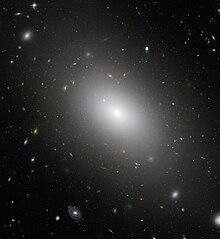Fossil galaxy system

Fossil galaxy systems represent a final form of the dynamic development of galaxy groups or galaxy clusters. They consist of a central elliptical giant galaxy , which is surrounded by significantly weaker galaxies and a diffuse extended X-ray halo.
definition
Fossil galaxy systems include galaxy groups as well as galaxy clusters that have reached the end point of their dynamic evolution. According to the definition, a fossil system consists of a spatially extended X-ray source with an X-ray luminosity of L X, bol ≥ 10 42 h 50 −2 erg / s as well as a dominant galaxy in the optics, which is at least two magnitudes brighter in the red than all satellite systems within the half the viral radius.
properties
Fossil galaxy systems show a wide variety of properties:
- The central galaxy in fossil systems can show weak core activity
- Their isophotes are predominantly, but not exclusively, disky . The term disky is roughly translated into German as disk-shaped or round.
- The speed dispersion between galaxies within the group or the cluster can reach low values of approx. 60 km / s but also considerably larger values of up to 800 km / s
- The absolute brightness in the red of the central galaxy can differ between fossil systems by five magnitudes
- The ratio of luminosity to mass can differ by a factor of 100 between fossil systems
- The distribution of the brightness of the faint companions of the central elliptical galaxy does not differ from that in normal groups of galaxies
Emergence
Two diametrically different development scenarios have been designed:
- The fossil systems arise from an interaction in the form of dynamic friction and collisions over the course of several billion years. The spiral galaxies merge to form an elliptical galaxy surrounded by dwarf galaxies . The X-ray halo consists of gas that was not used to form galaxies and of matter that was expelled from the galaxies during the collisions
- On the other hand, there is the assumption that most of the baryons were already used for the formation of the elliptical galaxy when the group was formed and that there were hardly any interactions with other galaxies later
The current observation data do not allow a distinction to be made between which of the two or whether both scenarios lead to the formation of fossil systems.
Examples
- CL 1205 + 44
- ESO 306-G017
- NGC 1132
- RX J0454.8-1806
literature
- M. Girardi et al .: Fossil Groups Origins IV. The relation between optical and X-ray luminosities . In: Astrophysics. Solar and Stellar Astrophysics . 2014, arxiv : 1403.0590v2 (English).
- S. Zarattini et al .: Fossil Groups Origins III. Characterization of the sample and observational properties of fossil systems . In: Astrophysics. Solar and Stellar Astrophysics . 2014, arxiv : 1403.0588v1 (English).
- S. Lieder, S. Mieske, R. Sánchez-Janssen, M. Hilker, T. Lisker, M. Tanaka: A Normal Abundance of Faint Satellites in the Fossil Group NGC 6482 . In: Astrophysics. Solar and Stellar Astrophysics . 2013, arxiv : 1309.1166v1 (English).
- Yuanyuan Su, Raymond E. White, Eric D. Miller: Suzaku Observations of the X-ray Brightest Fossil Group ESO 3060170 . In: Astrophysics. Solar and Stellar Astrophysics . 2013, arxiv : 1308.0283v1 (English).